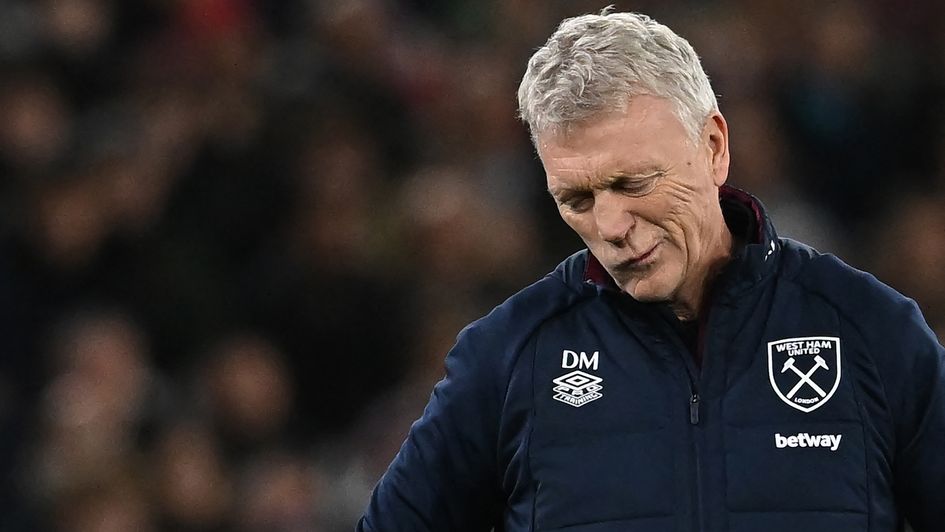
West Ham: Are David Moyes' Hammers as bad as Premier League position suggests?
Football designed for pragmatism rather than grand entertainment comes down the same way it goes up. There is no spectacular implosion, just a slow crumbling into the sea.
That’s why David Moyes’s West Ham United have only just come onto the radar as one of the Premier League’s lowest-ranking teams in 2022/23 and why, as he appears to inch closer to an exit, nobody is howling their complaints.
Moyes is a victim of his own success. His reappointment as manager in 2019 was widely seen as a backwards step by an unambitious board out of ideas and facing mutiny - and, for a club with a deeply ingrained association with attacking football, Moyes represented everything the supporters were against.
He was never going to be the man to restore the excitement of the Slaven Bilic era and therefore by qualifying the club for Europe, Moyes signed his own death warrant - as the influx of exciting and un-Moyes-y players last summer ominously foretold.
The headline purchase of Lucas Paqueta, part of a £160million spend that was the third highest (net) in Europe, showed the owners’ ambition went beyond the stodgy and conservative football Moyes has been offering.
But after five consecutive league defeats (halted by the 2-2 draw with Leeds last weekend) have left West Ham outside the relegation zone on goal difference alone, Moyes’s slow unravelling is not entirely a story of changing priorities at the top.
His players may also be a little bored of shuffling across in their neat rows, and having enjoyed successive top-seven finishes are perhaps, just like the fans and owners, pining for a more entertaining style.
That’s the impression you get from the low-energy, low-block, low-ambition displays that have plagued their season. From the very first match, a 2-0 defeat at home to Manchester City, West Ham have lacked a vital urgency and played with a defeatist mentality.
Gone was the snap of a counter-attack launched after possession was won, and gone was the sharpness of the pressing once the ball entered their half of the pitch. Something has felt a little off, as if everyone is waiting now for the waves to take them away.
Data points to no changes
But the stats tell a different story, and serve as a reminder that the eye test is sometimes too distracted by the accepted narrative to see what’s really going on.
West Ham’s average possession share is down slightly from 47.9% to 45.7%, but aside from that their underlying numbers in almost every area are the same or better.
Comparing this season to last, they still rank second for crosses (21.1 per match); their number of shot-creating actions has increased from 20.4 to 23.7 per game; their combined tackle and interception number is up from 23.9 to 25.7 per game; and the xGA (Expected Goals Against) has dropped from 1.53 to 1.36 per game.
And here’s the kicker: West Ham have the worst xGF (Expected Goals For) under-performance in the league, as per the graphic above via the Infogol model.
When you minus their xGF from their total goals scored you get -11, meaning they should have scored a whopping 11 more goals then they have, suggesting the only real difference between this season and the past two is the quality of their finishing.
Since pragmatic football is inherently dull, then it stands to reason that only the smallest change in luck would make the situation feel entirely different.
Lack of sharp-shooting costing Hammers
West Ham have scored just 15 times and five of those have been set-pieces, including three penalties, and although the reason for their goalscoring issue isn’t immediately obvious we can at least highlight Jarrod Bowen’s form.
His personal xG differential is at -3.9, the worst in the squad, although Paqueta (-1.7) and Tomas Soucek (-1.8) also help account for the downturn. Certainly, Soucek’s former knack for arriving in the penalty area at just the right moment seems to have disappeared.
Interestingly one of few players to be overperforming their xG is Gianluca Scamacca, who has endured a stop-start beginning to life in east London but who could, with a bit of help, come good in the second half of the campaign.
Add to this the return of Maxwell Cornet and Manuel Lanzini, restricted by injuries to just two league starts between them, and suddenly it looks like West Ham could be on the verge of a dramatic comeback.
These two being available would also give Moyes the option of removing Bowen and adding a little more verticality into the West Ham breaks, which is the only area in which they have notably diminished; last season they completed 8.05 dribbles per 90 whereas this year it is 4.78, explained mostly by the loss of Arthur Masuaku’s powerful overlapping runs. Cornet should be able to replace that aspect of Moyes’s tactics.
If only football was so rational, if only it was so data-driven. But this is an emotional sport built on the stories we tell, and Moyes is more vulnerable than most thanks to the aesthetic of the teams he puts together.
If fans, players, and the media decide he has taken West Ham as far as they can go - and that Cornet, Paqueta, Scamacca, and Said Benrahma should be rearranged into a more exciting attacking quartet - then it will infect performances and our perception of them.
That is no bad thing. Football is supposed to be fun, after all, and in an age when clubs of West Ham’s size are unlikely to better the sixth and seventh-place finishes of the last two years then the supporters do, at least, deserve to be entertained.
The underlying numbers tell us the system has not collapsed. That indicates the Moyesian way is still working. But it also means there is already a foundation in place for somebody more exotic to come in and turn the dial.